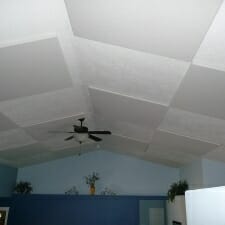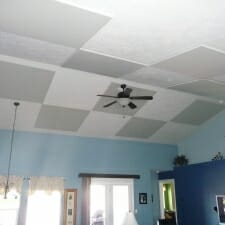King Residence
Residential acoustics are difficult because of the aesthetic that one needs to maintain. Surfaces that look like sheetrock are generally hard and will reflect sound. Surfaces that are soft and absorb echo almost always require some creative thinking to get them into rooms while not totally altering the look and atmosphere of the room. I tell people all the time that rooms are like people, what is going to work in one room probably isn’t going to work in another and it is best if each one is approached as it’s own entity.
I will make a few recommendations by including a few links to a few different products below. Once you have had a chance to review them, feel free to contact me with questions. The products listed below are in order of popularity in similar and previous situations – the top product being the most popular.
Fabric Wrapped Fiberglass Panels
Wall Mate stretch-wall system
Sound Silencer wall/ceiling panels
Echo Eliminator wall/ceiling panels
Most home owners don’t have thousands of dollars to invest into a project like this which is totally understandable! Therefore we need to try to find a solution that people can afford as well as one that looks like it should be there since you will be looking at it all of the time. The Fabric Wrapped fiberglass panels are going to be the most expensive and absorb the most sound of the four listed above (NRC: 85 = 85%). The price will depend on the overall size and color of each panel, so quantities and dimensions are needed to come up with a cost here. I usually tell people to ballpark at about $7.00 per square foot for the product (not including shipping) but I have seen residential panels with special fabric and labor sell for $15.00 per square foot.
The WallMate system ends up looking just like the fabric wrapped panels but is more costly. The “disadvantage” here is that it requires the most amount of labor considering it is a site fabricated system. Because it uses the cotton as the acoustical core, it is cost effective, and I will go into that in a second. Sometimes this is a problem, sometimes it’s not at all.
The Sound Silencer is a middle-of-the road product when it comes to the cost, but it is also the least absorbent (NRC: .45 = 45%). The Echo eliminator is the most cost effective and will absorb nearly the same amount of sound as the fabric wrapped fiberglass panels (NRC: .80 =80%). It looks like felt and the most common “issue” or “complaint” is that it is not finished looking enough. This is understandable because that is not it’s intent. It is supposed to be a cost effective, yet high-performance “nuts and bolts” type of product. These panels are almost always put into boxes and shipped via UPS Ground.
Another question is “how much do I need?” This is ultimately going to be up to you, but my recommendation has worked very well in the past. It is not a guarantee or an absolute, but it is just a starting point to open the conversation. Multiply the height, width and depth of the room to determine the cubic volume of the room. If the ceiling is pitched, average the ceiling height and use that. Then, multiply the cubic volume by .03 (3%). The value that you are left with is the approximate square footage of paneling that you need to install in your room to get you down to a comfortable reverberation time and take out the echo.
Example: If your room is 15’ x 25’ and the walls stop at 9’ and go to 12’ you would use the following equation.
Ceiling: (9 + 12 =21) (21 / 2 = 10.5)
15 x 25 x 10.5 = 3,937.5
3,937.5 x .03 = 118
This room would need approximately 118 s/f of paneling somewhere in the room.
Location is totally up to you, so depending on which product you are looking to install, the location of that product is an aesthetic call. The placement f the product is not dictated by acoustical performance. As long as the sound can hit the panels, they are able to do their job. I would not suggest putting the panels behind a cabinet or entertainment center or even behind artwork. The sound needs to be able to hit the panel and be absorbed.
Hello, Ted!
Our installation is finally complete. It came out great, and made a huge difference in the sound quality of our house. It took us 3 days (all together), and it was tedious to work overhead and make sure every measurement was right—but overall, given what we accomplished, a really good, straight-forward solution. I wouldn’t recommend self-installation to anyone who doesn’t have a really capable husband, but for us, it was quite do-able. And I am SO much happier with our acoustics. It’s a very discernable difference.
David and I think the timing, given the economy, is not quite right, but with all the carpetless, vaulted construction out there, your company could have a purely residential division that could do very well. It wouldn’t make the money per job, of course, as commercial, but it certainly could provide a much needed solution. The visibility just isn’t there for residential. It was hard for us to find a solution. But what a solution !
David and I talked about this midway through the project. Yes, it’s fine to use our photos. I would like others to be able to fix this issue in their own homes. You might let them know that if they try several designs to maximize use of the sheets of fiberglass (less waste = less cost) and choose a fabric that allows them to forego the underlaying fabric, it will bring their cost down considerably.
Take care, Ted.
Regards,
Theri






